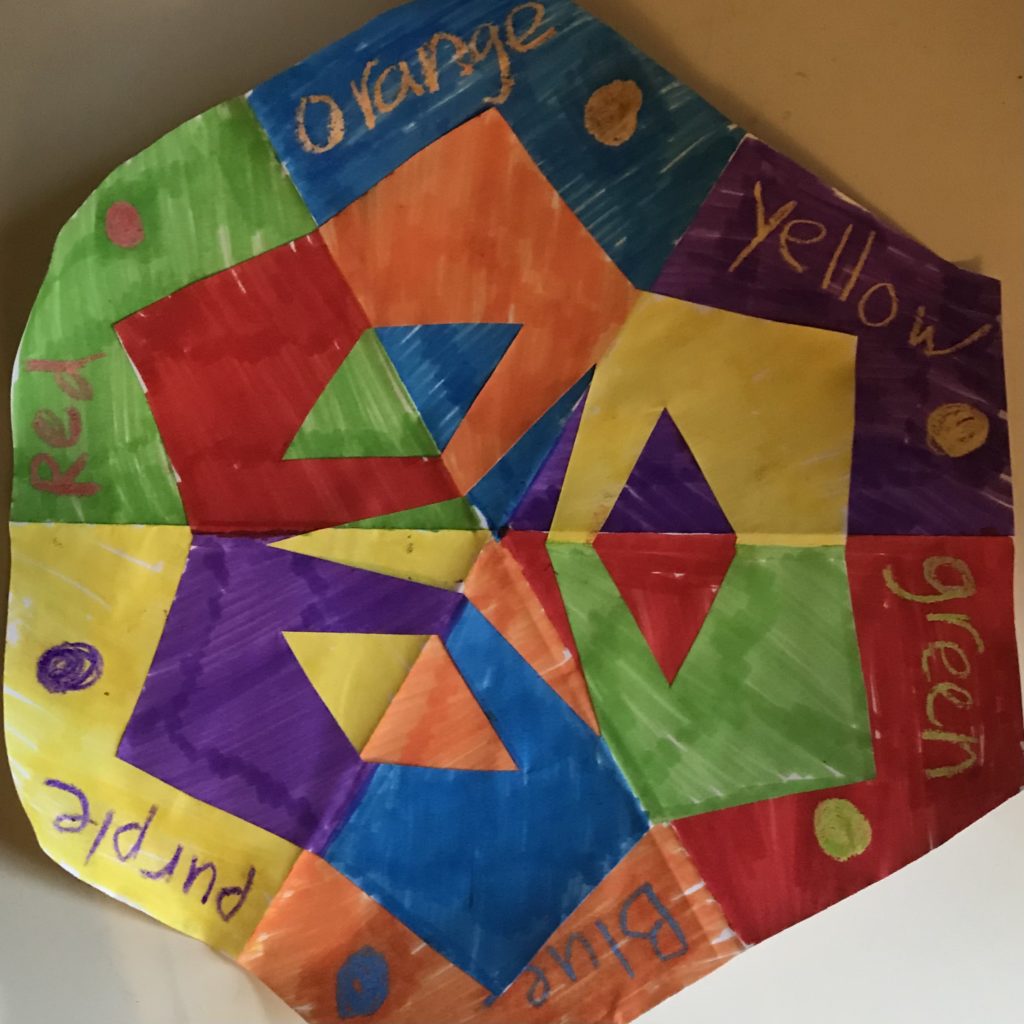You Will Make: One two-piece snowflake
You Will Need: Plain paper, crayons, markers
The Base: Make Two Hexagons
- Fold your paper in half short-ways.
- Mark but do not fold the mid point by matching the corners of the folded edge and pinching the middle.
- Using that mark as the center fold the corners inward so that the top edge meets where the new fold will form. This will make a sort of triangle or arrow shape.
- Cut off the extra pieces (in the video I made a very small hexagon to make the coloring faster, but it is more fun to make a full sized one).
- We will color first. DO NOT START CUTTING YOUR SNOWFLAKE YET
Colors: How to Mix and Relate
There are great talking points and visual support for this in the IGTV video, but sometimes it’s easier to remember if you can also read about it.

The first hexagon you should follow directions exactly. The second hexagon you should color how you want to, using lots of colors. Keep in mind what you learned about how colors relate as you do.
- A hexagon has six sections that match the number of colors:
- Red
- Orange
- Yellow
- Green
- Blue
- Purple
- In crayon, press hard: Make a red dot or pattern in one section. Skip a section and make a yellow dot or pattern in the next section. Skip once more and make a blue dot or pattern in the next section.
- These three colors are primary colors.
- They are called that because you can use them to mix other colors of pigment.
- Pigment refers to the stuff that makes your crayons and markers put color on the paper.
- In science or computer class if you learn about color, the rules are different because wavelengths of light are different.
- In crayon: put patterns or dots of the secondary colors between the primary colors you would use to mix them:
- Green, Orange, and Purple are called secondary colors because you can mix them.
- Orange = Red + Yellow
- Green = Yellow + Blue
- Purple = Blue + Red
- Now you have the whole rainbow. Analogous colors are next to each other.
- For example Red and Orange are an analogous pair
- Or Warm and cool colors form a triad (or group of three)
- Warm: Red, Orange, Yellow
- Cool: Green, Blue, Purple
- In Marker we will color complementary colors.
- Complementary colors are exact opposites. You can color in marker over the exact opposites.
- Red and Green
- Orange and Blue
- Purple and Orange
- Opposite colors create high contrast for our eyes and can show strong emotions.
- The marker will not stick to the crayon because the crayon is made of wax which repels water.
- If the marker sticks, use a paper towel or rag to wipe it off.
- Complementary colors are exact opposites. You can color in marker over the exact opposites.
Cutting the Snowflake
Once you feel like your hexagon colors look the way you want them to, you can cut ONE of your two hexagons into a snowflake to glue on top of the other.
- To cut your snowflake, re-fold it with the WHITE on the outside.
- Draw lines where you want to make holes on the edges of your triangle-ish shape.
- Cut them out carefully. If the paper is too thick, ask a grown-up to help.
- Open your snowflake and glue to the other one with a glue-stick.
Reflect
How does your snowflake feel?
How did you choose to use analagous and complementary colors?
Glossary and More Info
- Primary: colors that cannot be mixed in pigment
- Secondary: colors that can be mixed by combining primary colors
- Analogous: colors that are next to each other on the color wheel so they look related
- Warm: a triad (group of three colors) that feels warm to most people; Red, Orange, and Yellow
- Cool: a triad that feels cool to most people; Green, Blue, Purple
- Pigment: the chemical compounds that make up art materials. They are held together with a binder like wax, water, or clay
- Wavelengths: the different speeds at which light vibrates creat the way our eyes perceive color and for a slightly different set of rules for color theory on a computer screen. (Further reading about digital color)

1 comment